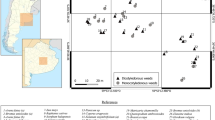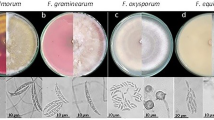Abstract
Twenty-seven seed samples belonging to the lettuce cultivars most frequently grown in Lombardy (northwestern Italy), in an area severely affected by Fusarium wilt of lettuce, were assayed for the presence ofFusarium oxysporum on a Fusarium-selective medium. Isolations were carried out on subsamples of seeds (500 to 1500) belonging to the same seed lots used for sowing, and either unwashed or disinfected in 1% sodium hypochloride. The pathogenicity of the isolates ofF. oxysporum obtained was tested in four trials carried out on lettuce cultivars of the butterhead type, very susceptible to Fusarium wilt. Nine of the 27 samples of seeds obtained from commercial seed lots used for sowing in fields affected by Fusarium wilt were contaminated byF. oxysporum. Among the 16 isolates ofF. oxysporum obtained, only one was isolated from disinfected seeds. Three of the isolates were pathogenic on the tested cultivars of lettuce, exhibiting a level of pathogenicity similar to that of the isolates ofF. oxysporum f.sp.lactucae obtained from infected wilted plants in Italy, USA and Taiwan, used as comparison. The results obtained indicate that lettuce seeds are a potential source of inoculum for Fusarium wilt of lettuce. The possibility of isolatingF. oxysporum f.sp.lactucae, although from a low percent of seeds, supports the hypothesis that the rapid spread of Fusarium wilt of lettuce observed recently in Italy is due to the use of infected propagation material. Measures for prevention and control of the disease are discussed.
Similar content being viewed by others
References
Chiocchetti, A., Sciaudone, L., Durando, F., Garibaldi, A. and Migheli, Q. (2001) PCR detection ofFusarium oxysporum f.sp.basilici on basil.Plant Dis. 85:607–611.
Forsberg, G. (2001) Heat sanitation of cereal seeds with a new, efficient, cheap and environmentally friendly method.in: Seed Treatment: Challenges and Opportunities.Proc. BCPC Symp. no. 76, pp. 111–116.
Fujinaga, M., Ogiso, H., Tuchiya, N., Saito, H., Yamanaka, S., Nozue, M.et al. (2003) Race 3, a new race ofFusarium oxysporum f.sp.lactucae determined by a differential system with commercial cultivars.J. Gen. Plant Pathol. 69:23–28.
Garibaldi, A., Gilardi, G. and Gullino, M.L. (2002) First report ofFusarium oxysporum on lettuce in Europe.Plant Dis. 86:1052.
Garibaldi, A., Gilardi, G. and Gullino, M.L. (2004) Varietal resistance of lettuce toFusarium oxysporum f.sp.lactucae. Crop Prot. 24 (in press).
Grube, R.C., Ryder, E.J., Koibe, S.T., McCreight, J.M. and Wintermantel, W.M. (2003) Breeding for resistance to new and emerging lettuce diseases in California.Proc. Eucarpia Meeting of Leafy Genetics and Breedings (Noordwijkerhout, the Netherlands), pp. 37–42.
Huang, J.H. and Lo, C.T. (1998) Wilt of lettuce caused byFusarium oxysporum in Taiwan.Plant Pathol. Bull. 7:150–153.
Hubbard, J.C. and Gerik, J.S. (1993) A new disease of lettuce incited byFusarium oxysporum f.sp.lactucum forma specialis nov.Plant Dis. 77:750–754.
Komada, H. (1975) Development of a selective medium for quantitative isolation ofFusarium oxysporum from natural soil.Rev. Plant Prot. Res. 8:114–125.
Matuo, T. and Motohashi, S. (1967) OnFusarium oxysporum f.sp.lactucae n.f. causing root rot of lettuce.Trans. Mycol. Soc. Jpn. 8:13–15.
Ryder, R.J. (1998) Lettuce, Endive and Chicory. CABI Publishing, Wallingford, UK.
Author information
Authors and Affiliations
Corresponding author
Additional information
http://www.phytoparasitica.org posting Dec. 16, 2003.
Rights and permissions
About this article
Cite this article
Garibaldi, A., Gilardi, G. & Gullino, M.L. Seed transmission ofFusarium oxysporum f.sp.lactucae . Phytoparasitica 32, 61–65 (2004). https://doi.org/10.1007/BF02980861
Received:
Accepted:
Issue Date:
DOI: https://doi.org/10.1007/BF02980861




